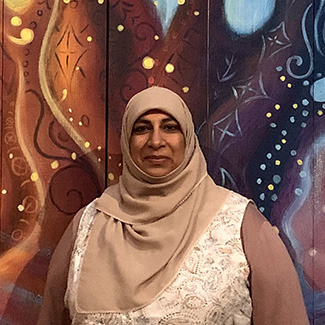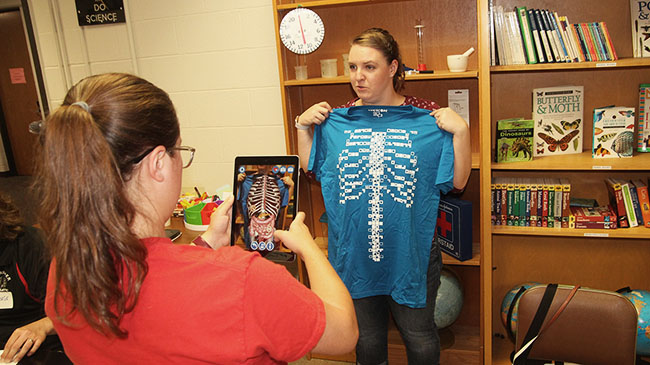
Assistant Professor of Elementary Science and Technology Education
School of Education
By Steven Krolak
(NEW ALBANY, Ind.)–Beliefs.
They frame our identity and shape our horizon.
They can limit, imprison, defeat us.
Or they can give form to our dreams and motivate us to pursue them.
A pre-occupation with beliefs figures strongly in the life and work of Sumreen Asim, assistant professor of elementary science and technology education.
As a devout Muslim woman, her religious belief is at the core of her love of learning. As a child of immigrants, belief in the promise of America has fueled her professional ambition. As a science educator, belief in the efficacy of technology has defined her research work and helped her surmount her greatest pedagogical challenges.
In blending these beliefs together, and in engaging the belief structures of her students and colleagues in positive ways, Asim has brought a new type of innovative presence to the classroom.
A changing dynamic
Visit Asim’s elementary methods class on any given day, and you are sure to find her students tinkering with some new educational technology. One day they might be trying out a new app on their phones or Apple iPads. Another day they might be wearing t-shirts that are electronically coded to reveal the inside of the human body. Or they might be fiddling with virtual reality headsets.
There’s learning involved. But the atmosphere is closer to play.
That’s entirely by design.
“I need to equip my students to meet the demands of tomorrow,” Asim said.
That means integrating technology into their training as teachers.
It’s particularly important because many of her students are not confident in teaching science, much less in using technology, a phenomenon that afflicts teacher training across the nation. So she must first focus on overcoming bias and anxiety.
That process begins with “getting to know you” assignments that help her understand their unique abilities, concerns and areas of interest.
“I like to highlight the backgrounds, experiences and needs of students, and sculpt classroom activities to most effectively meet their needs,” Asim said. “This consistently changing dynamic makes teaching my courses fresh and fun for me.”
What follows is an exercise in “backwards design,” in which she structures her course based on desired end goals, incorporating student interests and emphasizing questions. Classes are divided into team-based learning groups, complete with designated discussion directors, connectors and quizzers. While these groups are effective devices for critical thinking and diversity of perspectives, they also build camaraderie and trust, which in turn reinforce confidence.
“Creating interdependency within the classroom is valuable and ensures that the group progresses together,” Asim said.
With these structures in place, Asim is ready to introduce technological tools, essentially helping teacher candidates overcome their fears, and preparing them for the kinds of classrooms they are most likely to encounter.
Kahoot, Peardeck, BreakoutEDU, Nearpod, Merge Cubes, PHET simulations, gamification, Project Learning Tree, outdoor activities—these are just a few of the novel tools that she has most recently integrated into her methods course.

But they are not all. Asim is constantly on the lookout for new instructional methods. She frequently attends research conferences (usually as a presenter), webinars and other professional development events where new tech and best practices for its use are in the air. She accepts the need to change up her methods course, in light of new modalities and new students.
“Each semester I reinvent each course,” Asim said. “Keeping on top of new ideas in the education field allows me to apply new knowledge.”
Yet in acquainting her teacher candidates with the latest tools, she is not just helping them use gadgetry. She is teaching them to become innovators.
That means expanding their skills in areas such as communication, collaboration, critical thinking, creativity.
“Science content is intertwined with creativity,” Asim said. “Scientists use their creativity, innovation and imagination throughout the scientific process. This includes posing and developing research questions, designing investigations and then interpreting and formulating reasons for phenomena discovered in evidence collected in research.”
That approach informs her most recent scholarship, which focuses on changing the ways that students think about science and technology.
“Advancing the teaching practices through understanding the beliefs of our teacher candidates helps create discipline-specific strategies,” Asim said. “Applying this knowledge to course modification and development helps improve our methods course here at IU Southeast.”
Each student can learn
In her teaching philosophy, Asim echoes the simple but powerful commandment of her craft: “Each student can learn.”
It’s a call to respect the potential in every student. In her case, it’s a reminder of the highly unique road she has traveled, beginning with her highly studious childhood on suburban Long Island, New York in the 1980s.
Academics were never a challenge for Asim. She credits her parents with fostering a love of learning that combined fearless experimentation with high expectations. Her father was a computer scientist, her mother a pharmacist, both immigrants from Pakistan who had achieved success in their respective careers. Asim recalls the constant presence of early personal computers—black screens with flashing green lines of basic code. Her father was always bringing home new models for Asim and her siblings to toy around with, nurturing her fearlessness toward technology.
“He always said, ‘Jump on! Let’s explore!’” Asim said.
Asim was initially determined to become a doctor. When the recession of the early 1990s reduced the family income, she graduated from high school at age 15 and enrolled at Brooklyn College, commuting two-and-one-half hours each way and finishing her undergraduate degree while also working part-time in retail. Somewhere in that grueling time, she accepted the realization that her life goals–a family of her own before she was 30–would not be compatible with the demands of medical school or practice. When she broke the news to her father, and asked for his blessing for her shift to teaching, he was supportive.
“Teachers in Islam are on a pedestal,” he said.
Climbing that pedestal was another test of the strength of her beliefs–in herself, in her abilities, in the proposition that her achievements would bear fruit. With the help of grants and scholarships, she earned two masters degrees, and began to find her groove in science and environmental education, working with Dr. Eleanor Miele, who would become her mentor and friend, developing a passion for out-of-class learning and an appreciation for the value of partnerships with cultural institutions for teacher preparation.
Now married and with an infant daughter, she moved to Texas to pursue a doctorate, with the full support of her husband. It was here that she became first a graduate assistant for STEM educators, and then tenured member of faculty in that field.
Her own nonlinear journey has given Asim an appreciation for the uniqueness of her own students, and a respect for their sacrifices. Those hours on the Long Island Railroad and holiday shifts at The Gap enable her to relate to teacher candidates in similar life circumstances, and to draw on their perspectives when designing her courses.
A corollary of “each student can learn” is that each student brings something special to the learning experience.
Beyond the classroom walls
This past fall, Asim received the IU Southeast Diversity Award, reflecting her efforts in helping to foster an inclusive multicultural atmosphere on campus.
Those efforts include everything from a board where students can ask questions anonymously via post-it note and receive an answer on CANVAS, to securing a prayer space for fellow Muslim students and community members, and from working with colleagues to launch the first on-campus Muslim Meet-and-Greet to bringing education to marginalized children in the community through the Teach A Kid, Make Individual Life organization.
While the transition from self-awareness to advocacy is relatively recent, it is deeply anchored in her earliest teaching experiences in New York City schools, where she encountered approaches that were out of touch with the population.
“Traditional methods of teaching seemed ineffective and at best subpar to reach the diverse set of students in the urban school setting,” Asim said. “I sought to unlock ways to bring the students to their utmost learning potential.”
To unlock that potential is as much a spiritual as it is an intellectual exercise. For an educator who admits thriving on the intersectionality of science, technology, engineering, language arts and math, the first order of business is the humanistic embrace of all people and the special spark they share.
“Having cultural understanding and awareness allows relationships to build, brings together harmony and makes us emotionally intelligent,” Asim said. “Education does not stop at the classroom walls.”


